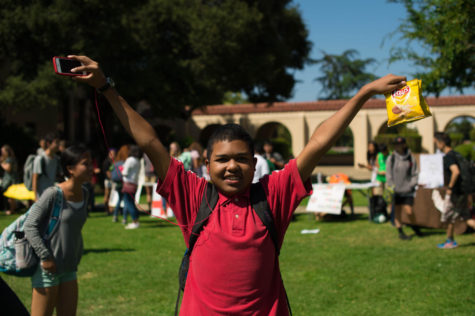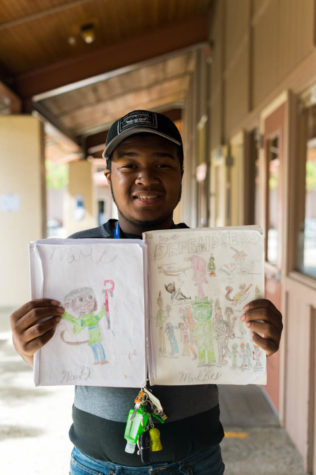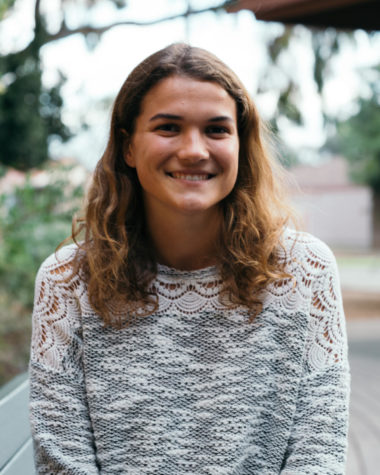Photo by Ryan Gwyn
Empowerment Education
It’s easy to assume that our physical differences and our various opinions are what set us apart from one another. However, it is important to remember that although these differences can potentially divide us, they also have the power to bring us together. Efforts to support students and help them reach their full potential, such as special education programs, have positively impacted students whose relationships with their peers may be under strain due to unacknowledged differences. The discussion about special education and the program’s students is surrounded by copious misconceptions. People often believe that students need constant assistance while doing the little things or that they are somehow less able, when in reality, what they often need is empowerment to fulfill their own full potential. Today, there are systems in place within schools in order to uplift students with intellectual and developmental disabilities and to better prepare them for the future.
October 20, 2017

The special education department at Paly consists of more than 200 students; however, within that, multiple programs exist. There is an Autism Spectrum Program called Academic Communication, Occupational Therapy programs, which focus on enhancement of a student’s motor skills and organization, and the Post-Secondary program, which helps adults from ages 18-21 stand on their own and maximize their exposure to real life experiences. Additionally, there is the Futures program which provides the chance for students with intellectual or developmental disabilities to receive an education that prepares students for life after Paly. The class has four focal pillars of learning: functional academics, vocational skills, community based instruction and general education inclusion.
The greater part of the class is practicing skills that students normally wouldn’t think twice about. “It is just skills that [others] can take for granted,” Erika Oakson a special education teacher at Paly said. “We’re still working a lot on reading and writing skills and spelling skills, reading for information, emailing and stuff like that.”
Students also work on math skills that are often related to money. Students practice calculating budgets and using math to schedule everyday life events, such as planning out their week and scheduling appointments.
Every Friday, the students go on outings within the community using public transportation. They have gone to the Cantor Arts Museum, Stanford Shopping Center and Downtown Mountain View for lunch. This provides an opportunity to practice skills such as understanding the bus systems and social interactions in public.
“Community-based instruction is one of my favorite things because there’s always opportunity for in-the-moment learning,” Oakson said. “There’s always unpredictable things out there that we need to talk about and discuss. It’s a lot of math, a lot of time, a lot of money, a lot of reading and really understanding what is going on… just applying all of those skills we’re learning on campus.”
Vocational training is also a large part of the students’ curriculum. By focusing on preparation for future employment, vocational training allows students to learn skills that may be applicable in a future employment. These skills are then applied in their student-run beverage businesses: Rise & Grind Paly and the Smoothie Business.
All students in the Futures program have various needs and require different amounts of help and attention. Not all students in the Futures Program have the opportunity to experience many classes in a standard education classroom. Due to varying needs, students spend different amounts of time in the Futures classroom versus the general education classroom.
“Obviously, it’s a lot easier to include someone with a significant disability into an elective class, like physical education or a photo class, because there’s not a rigorous academic component,” Oakson said. “There still have to be modifications; obviously, it would be easier [making modifications] than in, say, an eleventh grade US history class. As you get higher in grade, the academic gap gets bigger, so it’s very important that everyone’s included, because everyone deserves to be.”
Decisions as to which students get put into which classroom are decided by teachers in the special education department. The Instructional Leader of the entire special education department, Laura Bricca, helps the case managers decide what the best fit for their student is. Heather Johanson, the Inclusion Specialist, also has a large influence on the placement of students into some selected general education classrooms.
Johanson goes from class to class and sees what the students are learning and what she can do it make it more inclusive. “How do I get this student to be the most included as possible, access that curriculum, be able to work in a group,” Johanson said of her evaluation process in the in classrooms.
“It’s always a team decision, so no one person makes the final decision about what programming a student is going to receive,” Bricca said. “It’s always done in a collaborative team effort.”
The whole special education department is happy with what the Futures program has become and the opportunities students have been provided with. This program has given students a greater academic flexibility and created more inclusion within the Paly community.
“Erika Oakson, hands down, I think, is MVP,” Johanson said. “She has revolutionized the program. Seven years ago it used to be that this population of students that sort of stayed in their room, in the back of the school and they only ate lunch in one place… there were not a lot of vocational programs and the ones [Oakson] has developed are amazing. Between the smoothie business and the coffee cafe, these students are out and doing amazing skills, and that is all [Oakson].”


Aarun Visuthikraisee, a junior in the Futures Program, has a wide variety of interests. From swimming in the pool, to performing on stage, Visuthikraisee’s range of hobbies fill up most of his spare time. Visuthikraisee’s large interest for music began his passion for instruments such as the trumpet and piano.
Visuthikraisee has been playing the trumpet for the Paly Pep band since his freshman year. Visuthikraisee attends every home football game and plays the trumpet while cheering on the team.
As a result of his love for trumpet, Visuthikraisee took up playing the piano as a new way to learn more about music. Over the summer, Visuthikraisee had a blast at a week long jazz camp where he learned to play many new pieces.
Besides music, Visuthikraisee has a love for performing arts. He has spent his time performing for an acting company called Youth Drama For All (YDFA). YDFA gives both special and general education students the opportunity to participate in theater and pursue acting as a hobby. Theater was a new form of art that he never ventured in before, but YDFA helped him quickly find joy in acting.
Visuthikraisee continues to discover both new forms of performing art as well as pursuing his passion for swimming. When he’s not playing an instrument, you can find him swimming breastroke in the clear, blue water of the swimming pool.


A senior in the Futures Program, Joseph Worku, often featured on InFocus, is recognized across the Paly campus for his outgoing and cheerful personality. Worku is one of three seniors in the Futures Program, and, although he is sad to leave the Paly community, he is ready to graduate and see what’s in store for him after high school.
After watching many different films, Worku found a spark of interest in creating his own. Recently, Worku completed his very first film, “The Adventures of Joseph and Mr. Wallace.” This chronicles his adventures with Mr. Wallace, his teddy bear. “It’s a movie about us going on an adventure to visit Disneyland,” Worku said. His short film was inspired by his trip to Disneyland as a child, where he loved going on the “It’s a Small World” ride.
Similar to the majority of high school students, besides film, Worku enjoys spending time with friends. Worku has been a Best Buddies member since his freshman year and loves hanging out with his buddy, and other club members, as often as possible. Worku and his buddy from last year, Kate DeAndre, class of 2017, often spent time together going to the movies. “My favorite thing about Best Buddies is I like to hang out, talk and chat,” Worku said.
There are also times where the entire Paly Best Buddies program gets together for larger events. One of the events that occurred at the end of last year was the pool party at the DeAndre’s house. “I had a wonderful time having a pool party,” Worku said. “I swam and watched Despicable Me.”
Worku has great appreciation for the Best Buddies organization and is sad to leave the chapter at Paly. He has made so many lifelong friendships because of it and will always the fun he had here.


As one of the three seniors in the futures program, Sophia Lieb has become a dedicated and hardworking student leading up to her senior year. From fashion and design to her position in Best Buddies, Lieb demonstrates her heartfelt love in all of her interests. Lieb is highly invested in the Best Buddies organization, as she is currently one of the seven club officers for the 2017 school year. Her role as Buddy Director gives her the responsibility to check events on the calendar and keep everyone updated on meetings. This school year Lieb hopes to be paired with a freshman so she can educate a younger student on the Best Buddies chapter and be a mentor to someone new to Paly.
The Best Buddies club has created great excitement throughout her life and has offered many opportunities. Last year, Sophia represented Palo Alto High School at the 2016 Best Buddies Game Changer Reception where the Palo Alto chapter was recognized as the Game Changer in Friendship. Along with a majority of the other students in the Futures Program, Lieb feels Best Buddies has given her everlasting memories.
Lieb also enjoys singing in her free time. She has been a member of Palo Alto High School’s choir all the three years leading up to her senior year. Her time in the choir gave her the opportunity to perform in front of a large crowd, which is one of her favorite things to do. In the future, she hopes to become a professional singer so she can perform on the big stage like many of her celebrity idols.
With the opportunities she’s had at Paly, Lieb has made many friends, making her time here more enjoyable and memorable. She has gotten a chance to try out many different activities and discover her passions and she will keep these skills with her throughout her life.


“It just hit me one day that I should be making my own superheroes,” a junior in the Futures Program, Mark Pace, said. We all love heroes: whether they’re on the silver screens or on the pages of books, the action-packed lives of our favorite world-savers never fail to spark something from our imagination. Pace’s personal passion for superhero comics fills the pages of his handmade comic books with stories of heroes inspired by his very own life.
This year, Pace is taking Paly’s Game Design course, where he is gaining expertise to use while transferring his ideas to life. His stories are mainly inspired by fond memories, such as his summer trip to Warner Bros Entertainment Studios in Hollywood, or just characters that he really likes.
In the Game Design course, Pace is currently making his own video game. “I am making a golden toad fight back an evil scientist,” Pace said. “He’s planning to poison the water supply.”
Along with Game design, Pace enjoys drawing using computer applications to create colorful animations and short films. His short films are uploaded to his YouTube channel, Palo Alto Comics, which is also the name of his production company.
Pace’s love for creation began with comics, which is still his favorite form of art today. Pace is currently working on two projects, both of which are homemade comic books. The books are filled of detailed pictures and colorful superheroes. Pace has been working on these comic strip stories for the past year and believes they won’t be completed until 2018.
Throughout the years, Pace has taken many different art classes at Paly in hopes of discovering new styles he is passionate about. Whether it is drawing, blowing glass, or designing and animating films and games, he loves discovering the forms of art that help him live out his artistic passions best.

Georgetown University alumni Anthony Shriver founded the Best Buddies program in 1987. Shriver decided to take action when he noticed a severe lack of inclusion in his community and global communities between those with and without intellectual and developmental disabilities (IDD). He made it his mission to close this gap by eventually founding Best Buddies. Today, Best Buddies is an international organization focusing on building strong relationships between people with and without IDD and constructing a basis for integrated employment and leadership.
The Best Buddies organization is inclusion-based and follows three main pillars of development: building one-to-one relationships, working to further integrated employment and overall leadership growth. Their one-to-one friendship building works to improve set social skills while at the same time fostering friendships between those with and without IDD. Their work on integrated employment guides people with IDD through providing for themselves, equipping them with the skills and knowledge to find employment in their area and play a role in their local community. The leadership development pillar empowers people with IDD practice techniques such as public speaking and building leadership skills to become better community members. The three pillars of Best Buddies empower and support people with IDD.
Best Buddies International has spread throughout all 50 states as well as 45 different countries. Chapters have been started in middle schools, high schools and universities around the world. Today, there are 2,151 chapters across the entire globe. Best Buddies Citizens is another branch of the organization that focuses on socialization throughout the adult community. People with IDD are paired with other local community members and, by spending time together, share a mutually-beneficial and enriching friendship.
Best Buddies is separated into six different categories: matching, meetups, events, communication, email, and organization monitoring. People are matched in their “friendship pairings” based on shared interests and hobbies. These friendship pairs require a yearlong commitment, but typically exceed this as the friendships form. The organization requires joint activities at least twice a month. Events are planned by the Best Buddies Chapters within their school or community. The “buddies” are supposed to communicate with one another at least once a week through email, phone calls, or face to face interations. E-buddies, the online version of Best Buddies, talk at least once a week through email for a span of at least a year. Staff members offer support and ensure communication and interaction is running smoothly within friendships. The program contains two different types of advocacy opportunities: Best Buddies Ambassadors and Best Buddies Promoter Chapters. Ambassadors are people with IDD who work to educate others with IDD on how to properly advocate for themselves and their peers. They also work to teach people to improve their public speaking, higher their self-esteem and to be confident.
Promoter Chapters, are Best Buddies chapters at schools without a special education program, but have a goal to advocate for their peers with IDD.
Paly is lucky enough to have an award-winning Best Buddies program that has been around for five years. Last year, Paly was selected to win one of the four Game Changer awards for the region of Northern California. This award highlights inclusion in friendship, employment, leadership. Paly was awarded with the Game Changer in Friendship award for the academic school year of 2015-16. The chapter currently holds roughly 100 members and seven officers. Palo Alto High School’s Best Buddies chapter meets twice a month at lunch and has monthly events outside of school.
After signing up, members have two options to decide their commitment to the club. Peer Buddies are placed into one-on-one pairs; friendship pairs meet up on a weekly basis, either outside or inside of school. Peer buddies also complete monthly friendship updates to track the progress of the friendship. An associate buddy does not have one specific friendship but instead creates and starts friendships with multiple students.
“I will see some of the students in Best Buddies walking across campus and just giving high fives, and not that cheesy ‘hi’; it’s truly genuine,” said inclusion specialist Heather Johanson. “I know you, I’m stopping to talk to you because I know you. It’s a true authentic interaction, not like a pity interaction. It is truly the understanding of somebody else on both sides and it’s so powerful between a general ed student and a special ed student.”
In order to become part of a peer or associate buddy pairing, you must first be interviewed by a club officer to see if you match well with another buddy. “We try to match students on interest and who we think will kind of click just like anywhere else,” Erika Oakson, a Futures Program teacher, said. “Some people click more than others.” As a result, many students in the Best Buddies chapter at Paly who do not have an IDD do not end up receiving a buddy pairing for the year. Club members not chosen as a peer buddy participate as associate buddies, and are still invited to all monthly club meetings and events throughout the school year.
The Best Buddies organization has increased the social companionship in many students with and without IDD. Throughout the school, it has provided the opportunity for members to meet new people and make new friendships, effectively building and overall more inclusive school environment.


